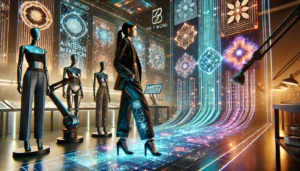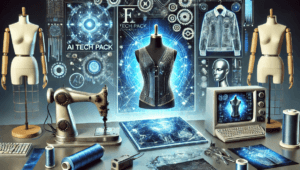Look behind the curtain and explore the incredible technology bringing virtual fashion shows to life.
Behind the scenes of every mesmerizing virtual fashion show lies a world where creativity transcends physical boundaries, powered not by fabric and thread, but by code and cutting-edge technology.
These shows are not just visual spectacles; they represent a fusion of artistry and innovation inviting viewers into an interactive realm. Immersive tech like virtual reality (VR) headsets let viewers feel like they’ve stepped onto a fantastical runway, while augmented reality (AR) enables virtual try-ons.
Virtual Fashion Core: 3D Modeling
At the core of this digital revolution is 3D modeling, a technology enabling detail and all sorts of creative possibilities.
- A Virtual Tailor: 3D fashion design is the digital equivalent of tailoring. Designers craft garments with unparalleled precision and creativity, adjusting weight, drape, and the way they stretch and wrinkle. Picture virtual clothing swaying swiftly with the grace of silk. This level of realism makes digital clothes feel tangible.
- Fabric Fantasy: 3D fashion designers can defy the limitations of physical world fabrics, creating original materials with textures only the digital world allows. Imagine shimmering dresses with ethereal luminosity.
- The Devil’s in the Details: From intricate beadwork to delicate embroidery, every detail can be meticulously rendered, rivaling the craftsmanship of physical garments. Close-ups on virtual catwalks will show you an astonishing level of detail.
- Fashion Design’s Future: 3D modeling isn’t just creating mind-bending shows. It allows digital fashion designers to refine their ideas before physical production, visualize garments for specific clients, lights and occasions, aiding in perfecting each piece.
Sustainability’s Best Weapon
Beyond its creative potential, 3D fashion is the industry’s best weapon to propel sustainability. Brands can minimize waste by allowing designers to experiment endlessly without the need for physical prototypes. Creators can take big risks and refine ideas without using lots of expensive fabrics.
The lavish sets, flights for models, and enormous energy consumption that come with traditional fashion shows are become obsolete when it comes to virtual fashion shows. These digital events can be designed and staged almost entirely online, massively reducing ecological footprint.
- Motion Capture: Bringing Avatars to Life – Motion capture tech brings incredible precision and expressiveness to the virtual fashion show experience.
- Going High-Tech: Camera-based systems and marker-less motion capture allow for freer movement and a less cumbersome experience for the models.
- Precision for Realism: Capturing not only grand gestures but also subtle micro-movements like muscle twitches, the weight shift in a turn or a nuanced head positioning, ensures avatars exude lifelike realism.
- Fashion With Flair: Each model’s unique walk and charisma are faithfully translated into the digital realm through modern motion capture, imbuing virtual shows with the same distinct flair as real-world runways.
- Interactive Spectacle: Models seamlessly interact with their digital environment, whether running their hand through a virtual waterfall cascading from their sleeve or responding to dynamic changes generated by AI. Motion capture transforms models into interactive, integral parts of a fantastic spectacle.
AI Bringing the Wow Factor
AI’s role in virtual fashion shows is nothing short of transformative. AI-generated stages pulse with life, bloom with flowers, react to music, even mimic the texture of the fabric itself. This way, audiences can immerse themselves in virtual environments powered by cutting-edge technology.
Virtual garments come alive with dynamic textures and patterns that react in real-time – dresses that pulse with light or the soundtrack, fabrics that shift with models’ movements-creating magic for viewers.
AI’s also proactive, suggesting unique textures, silhouettes, art, creating entirely virtual garments that push the boundaries of fashion.
Augmented Reality: Blurring the Lines of Reality
While virtual fashion shows intrinsically dazzle, including AR turns viewers into participants.
More than watching a video, AR lets you see the incredible designs directly from your living room. Also, snapping photos of yourself wearing pieces from the show or recording a video of you modeling it.
Likewise, AR is a powerful marketing tool for brands. AR allows for virtual try-ons to increase interaction among users and create a sense of personalization and trust.
Read:
NFTs and New Type of Ownership
NFTs take virtual fashion shows from spectacle to exclusive investments.
People can not only attend out of this world virtual fashion shows but select digital pieces and buy them after brands mint them as NFTs. Attendees can bid on these one-of-a-kind items and their own exclusive items.
Some NFTs come with their physical versions or special access to a designer’s digital fashion world, creating a bridge between both worlds and a fulfilling customer experience.
FAQs:
1. What are virtual fashion shows?
Virtual fashion shows are digital events that showcase fashion collections using advanced technology like 3D modeling, augmented reality (AR), and artificial intelligence (AI). They offer an immersive and interactive experience that transcends physical boundaries.
2. How does 3D modeling contribute to virtual fashion shows?
3D modeling is central to virtual fashion shows, enabling designers to craft digital garments with remarkable precision and creativity. It allows for realistic simulations of fabric weight, drape, and texture, as well as creating intricate details like beadwork and embroidery.
3. How do virtual fashion shows promote sustainability?
Virtual shows eliminate the need for physical prototypes, lavish sets, and travel for models, significantly reducing waste and carbon footprints. Designers can experiment with ideas digitally, reducing fabric usage and resource consumption.
4. What is the role of motion capture in virtual fashion shows?
Motion capture brings lifelike realism to digital avatars. It captures everything from grand gestures to subtle micro-movements, ensuring models’ unique walks and charisma are faithfully translated into the virtual realm.
5. How does AI enhance virtual fashion shows?
AI generates dynamic, interactive stages that respond to music, model movements, and other elements. It can create virtual garments with textures and patterns that shift in real-time, adding a magical, immersive touch to the shows.
6. What is the significance of augmented reality (AR) in virtual fashion?
AR enhances interactivity by letting viewers try on virtual clothes from their homes or see designs in their environment. It also serves as a powerful marketing tool by creating personalized experiences and increasing customer trust.
7. What are NFTs in virtual fashion shows?
Non-fungible tokens (NFTs) turn virtual fashion into exclusive investments. Attendees can bid on digital garments minted as NFTs, with some offering physical versions or access to exclusive digital fashion worlds.
What would you like to see in a virtual fashion show? Tell us below or on social media!



1 thought on “Behind The Glam: The Tech Powering Virtual Fashion Shows”
Their posts always leave us feeling informed and entertained. We’re big fans of their style and creativity.